|
FINDING THEIR WAY
by Bob Brooke
Today, many people use GPS programs to find their
way, but back when the automobile first came into existence, the road
map became an essential tool to finding their way around. Prior to the
mid-1890s, bicyclists were the ones who demanded good road maps. The
systematic mapping of roads and the installation of route signs by the
U.S. Government didn’t occur until the automobile arrived. But as the
new century dawned, the number of automobiles on American roads began to
increase and so did the demand for accurate road maps. The Chicago
Times-Herald printed the first automobile road map in the country for a
race they sponsored from Chicago to Waukegan.
 Originally,
drivers purchased gasoline for their automobiles in barrels and brought
it home or pumped it out of a barrel at a grocer or dry goods store.
While historians dispute the location of the first true drive-up service
station, some contend it was a Standard Oil of California station that
opened in Seattle in 1907. Others believe that the Gulf Refining Company
of Pittsburgh built and operated the first modern service station in
Pennsylvania in 1913. They also believe that this Gulf Station handed
out the first free road map. Originally,
drivers purchased gasoline for their automobiles in barrels and brought
it home or pumped it out of a barrel at a grocer or dry goods store.
While historians dispute the location of the first true drive-up service
station, some contend it was a Standard Oil of California station that
opened in Seattle in 1907. Others believe that the Gulf Refining Company
of Pittsburgh built and operated the first modern service station in
Pennsylvania in 1913. They also believe that this Gulf Station handed
out the first free road map.
In 1918, Wisconsin’s state legislature created a
numbered highway system., which the federal government adopted in 1926.
This new national highway system included such legendary roads as Route
66 and California’s scenic Highway 1. Rand McNally became the first
major map publisher to adopt the system, which it also helped promote by
installing numbered signs along these national roadways.
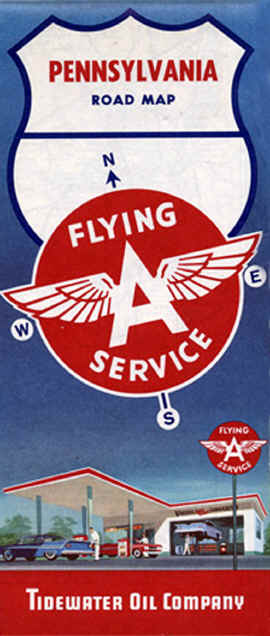 Before
the 1920s, road maps between cities were uncommon. A major problem with
all road maps before that time was that few marked streets. It wasn’t
until automobiles became more widespread that both street maps and road
signs became essential. Companies like B.F. Goodrich paid for the
posting of street signs. Before
the 1920s, road maps between cities were uncommon. A major problem with
all road maps before that time was that few marked streets. It wasn’t
until automobiles became more widespread that both street maps and road
signs became essential. Companies like B.F. Goodrich paid for the
posting of street signs.
Some of the most rare and most historically
interesting service station maps are those produced between 1920 and the
end of World War II. This golden age of service station maps produced
some with superb Art Deco designs and images of old autos. After the
War, and especially with the expansion of the federal highway system in
the 1950s, illustrations on maps featured dynamic scenes and graphics
printed in vibrant colors. But after 1965, the quality of service
station maps declined until their virtual disappearance in the 1980s.
Oil producers such as Esso, Chevron, Shell, Gulf,
Standard, Texaco, and Socony- Vacuum—later known as Mobil—all
distributed maps. In addition, banks, auto clubs, and tourist agencies
gave out maps to their customers and members.
Road maps belong to the growing category of
collectibles called "petroliana," or anything to do with gas
stations and the petroleum industry. For the most part, they’re
reasonably priced, and some estimate that during their peak service
stations distributed over eight billion. Oil companies provided them as
a service. They were made to be disposable, marked up by the gas station
attendant as he gave directions and sent his customer on their way. But
people often saved maps as souvenirs of the trips they made.
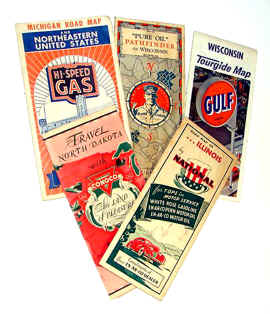 As
automobiles proliferated, the marking of routes changed. Before numbered
roads, stripes of paint on telephone poles, fence posts, or trees
delineated the various routes, such as the Kit Carson Trail, the Red
Ball Route, the Dixie Highway, and the Bee Line. As
automobiles proliferated, the marking of routes changed. Before numbered
roads, stripes of paint on telephone poles, fence posts, or trees
delineated the various routes, such as the Kit Carson Trail, the Red
Ball Route, the Dixie Highway, and the Bee Line.
In 1925, states began numbering their roads. At first
it was an adventure to drive, but by the 1930s it had turned into a
method of tourism. Tourist cabins and cafés sprang up along the way, as
motorists made their way across country. Historians consider this time
the road map’s golden age.
The Sinclair Oil Company hired noted artists like
Peter Helck, who also produced advertising illustrations for car
companies. Maps featured images of a carefree and playful life on the
road, with service stations welcoming children and dogs, many of which
were Scottish terriers, like the ones popular in movies like "The
Thin Man." Map covers also featured idyllic illustrations of gently
rolling hills and beckoning horizons.
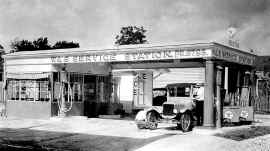 Map
images also showed the cleanliness of station restrooms and the
helpfulness of their attendants. In those days, customers who purchased
gas also got their windows cleaned and oil checked free of charge. Maps
often displayed images of attendants playing with children and pets
before handing the driver a free map and sending him on his merry way. Map
images also showed the cleanliness of station restrooms and the
helpfulness of their attendants. In those days, customers who purchased
gas also got their windows cleaned and oil checked free of charge. Maps
often displayed images of attendants playing with children and pets
before handing the driver a free map and sending him on his merry way.
In the 1920s, maps also often showed airplanes, boats
and other exciting vehicles that used the fuel and oil produced by the
company issuing the map. Graphic design became more sophisticated by the
1930s, often believed to have been the golden era of the map.
Among the most sought-after items are the large
five-panel maps of the 1930s issued by the Sinclair Oil Company, which
hired artists like Peter Helck, a well-known painter also noted for his
advertising illustrations for car companies.
Maps produced during World War II reminded motorists
to slow down to save tires. After the War, maps featured dynamic scenes,
vibrant colors, and great graphics.
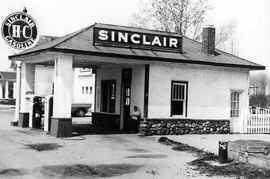 By
the baby booming 1950s, the images tended to show nuclear families—a
mom, dad, son and daughter, all enjoying life on the road. During the
1960s, maps displayed the dotted lines of planned Interstates and aerial
views of highway cloverleafs. By
the baby booming 1950s, the images tended to show nuclear families—a
mom, dad, son and daughter, all enjoying life on the road. During the
1960s, maps displayed the dotted lines of planned Interstates and aerial
views of highway cloverleafs.
Three companies—Rand McNally, H. M. Gousha, and
General Drafting— produced most of the service station maps. These
became a vehicle through which oil companies could promote the service
at their stations, for it was service that differentiated them.
General Drafting produced maps for Esso, whose
attendants handed out some 34.5 million maps in 1965. After 1965, the
quality of service station maps declined until their virtual
disappearance in the 1980s.
Today, of course, free maps are long gone. They faded
away, along with so many other aspects of the highway culture, with the
1973 energy crisis.
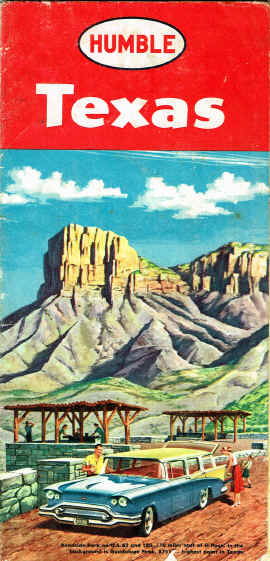 Road
maps, especially the ones produced by oil companies for their service
stations, are highly collectible. People collect road maps for many
reasons. Some use them to document local history, some assemble
collections of rare service stations, and others assemble a complete
station series for the US. Many gas station maps are cross collectibles.
In other cases, their covers may coincide with major events, like
World's Fairs, or because they show Disney characters, or because they
reflect local historical events, like Civil War battles. Road
maps, especially the ones produced by oil companies for their service
stations, are highly collectible. People collect road maps for many
reasons. Some use them to document local history, some assemble
collections of rare service stations, and others assemble a complete
station series for the US. Many gas station maps are cross collectibles.
In other cases, their covers may coincide with major events, like
World's Fairs, or because they show Disney characters, or because they
reflect local historical events, like Civil War battles.
It’s often possible to date service station road
maps by the name of the oil company. For instance, Esso became Exxon in
1973. Other service station maps, like Sinclair, Tydol, Flying A
disappeared from large portions of the country in the 1960s when they
lost market share.
While older ones can be worth higher amounts,
depending on their condition, newer ones aren’t as pricey. Early road
maps from the first decade of the 1900s can be worth $75-100 today in
good condition. Those from the 1920s and 1930s range in price from
$20-40. Groups of maps from the 1950s sell for $10-20. Most of the
damage to road maps occurred in their refolding, for few motorists ever
mastered the art of folding a map correctly after use.
Illustrations:
The Sinclair Oil Company hired noted artists like Peter
Helck, who also produced advertising illustrations for car companies.
Road maps such as this one illustrated the future of
automobile travel with modern service stations along the way.
Road maps, especially the ones produced by oil
companies for their service stations, are highly collectible.
An old photograph of an early Texaco Service Station.
A photograph of a Sinclair Oil Service Station.
Humble, one of the many oil companies in the southwest,
gave away this Texas road map to its customers. |